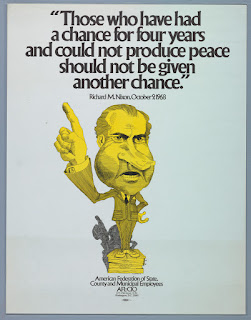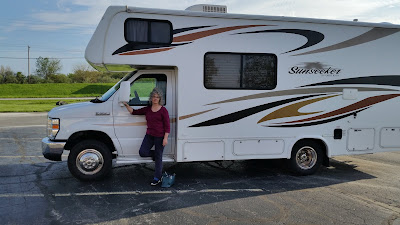 |
| Me in 1972 |
I don’t know if they were starved for workers, or if I was a
particularly good at my work, but they increased my responsibilities. My next
assignment was to look through the daily papers, cut out any articles relating
to McGovern, and add them to a scrapbook. Then I would take the scrapbook
upstairs to Democratic National Committee (DNC) Chairman Lawrence O’Brien’s
office.
I was rewarded with buttons and posters. My favorite was a
caricature of Richard Nixon standing on a soap box saying, “Those who have had
a chance for four years and could not produce peace should not be given another
chance,” dated October 9, 1968. At that time, he was running against Hubert Humphrey, and won. The joke was that now it was four years later,
and Nixon was still president, still at war in Vietnam.
 |
| Some of my souvenirs from the McGovern campaign. |
The campaign asked if I would work at the DNC headquarters, which were in – yes – the Watergate office building. The campaign would shuttle me over there from K Street, which was key, because it wasn’t easily accessible by bus.
The infamous break-in had already happened in June. On my first
day there, as we walked into the 6th floor office, my escort told me
that the door we were walking through was the one that was taped open by the
burglars, who had been caught red-handed. It had not yet developed into the scandal that would cause Nixon to
resign two years later.
At the DNC, I worked in a room adjacent to an audio booth of a recording studio. We had a rack of audio tapes, like 8-track tapes, of recent McGovern appearances. We used what were very high-tech telephones at the time. They had a slot for a thick, credit-card-sized plastic punch card which would auto-dial the number of a radio station news desk. I would pick up the receiver, put a card in the slot, and wait for someone to answer. I would look at the day’s cheat sheet and say, “this is the Democratic National Committee, I have a tape of George McGovern speaking at some place. Are you interested?” They might say “No” or ask about its content or length. If they wanted it, they would do something with their phone, and I would push the tape into a player.
 |
| Information packet given to DNC radio volunteers. |
Meanwhile, I was adjusting to the Junior High school experience.
Instead of one teacher per grade, I had different teachers for different
subjects. One of my favorite teachers was for Social Studies, coincidentally
named Mr. Nixon. Delbert Nixon, no relation to the president, was an average
height, middle-aged African-American man with short hair and a mustache.
As we neared the election, Mr. Nixon began to set up glass cases in the hallway near his classroom. On either side of the hall, one case would feature Nixon and the
other McGovern. After class one day, I offered that I was working for McGovern
and could get some campaign paraphernalia for the display. He drove us after
school to the K Street HQ and we picked out some things, including my favorite
poster.
 |
| Another souvenir from the campaign. |
Woodward and Bernstein of The Washington Post revealed some of this before the election, but the “smoking gun” White House tape would not emerge until later. Meanwhile, McGovern was portrayed as the “acid, amnesty & abortion” candidate. Nixon won 60% of the popular vote, and McGovern only carried DC and Massachusetts in the Electoral College.
 |
| George McGovern from 1972 poster, by Gary Yanker, courtesy Library of Congress Prints and Photographs division. |
Ten years later, I was a senior at Northwestern University in
Evanston. A Political Science major, I learned that McGovern would be teaching
a class. At first, we were told that it would be an small upper-level seminar, which
was great. But demand was much higher, and “C-41 U.S. Foreign Policy” ended up
being in the huge Tech Auditorium. After class, there were always students
hanging around, asking questions. I really wanted to tell him that I had worked
for him against Nixon. I eventually did, and he was quite gracious. I ended up with a
B in the class.
In 1984, McGovern decided to throw his hat into the ring again,
but he didn’t get far in the primary. That’s just as well, because the
Mondale-Ferraro ticket eventually lost to the Reagan-Bush re-election campaign in an even
bigger landslide than in 1972. But McGovern was on the ballot for the
1984 Illinois democratic primary. I was old enough to vote this time, so I voted for
him.
Afterword: In 1972, I did not know that McGovern, whose father was a Methodist minister, had studied at Garrett Theological Seminary, on the Evanston Northwestern University campus in the late 1940s. He was a student minister for a time, but was never ordained, instead ultimately receiving an M.A. and a Ph.D. in History from NU. As I was putting the finishing touches on this post, I came across an interesting Bible verse. I was not searching for a quote, but happened to read this, which seemed strangely appropriate. From the book of Nehemiah, chapter 8, verse 3:
Afterword: In 1972, I did not know that McGovern, whose father was a Methodist minister, had studied at Garrett Theological Seminary, on the Evanston Northwestern University campus in the late 1940s. He was a student minister for a time, but was never ordained, instead ultimately receiving an M.A. and a Ph.D. in History from NU. As I was putting the finishing touches on this post, I came across an interesting Bible verse. I was not searching for a quote, but happened to read this, which seemed strangely appropriate. From the book of Nehemiah, chapter 8, verse 3:
And he read therein before the street that was before the water gate from the morning until midday, before the men and the women, and those that could understand; and the ears of all the people were attentive unto the book of the law.
































